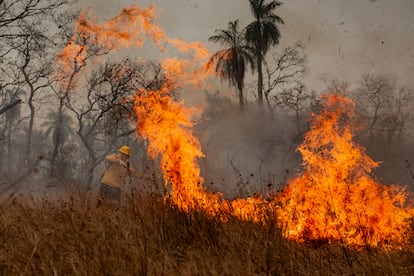A new generation of firefighters fighting fires that respect no borders

Strictly opinion pieces that reflect the author's unique style. These opinion pieces must be based on verified data and be respectful of individuals, even if their actions are criticized. All opinion pieces by individuals outside the EL PAÍS editorial team will include, after the last line, a byline—no matter how well-known the author may be—indicating their position, title, political affiliation (if applicable), or main occupation, or any that is or was related to the topic addressed.

In the Americas, fire is no longer a seasonal visitor : it has become a permanent resident. In 2024 alone, more than 950,000 square kilometers —an area larger than Bolivia—burned across the continent. The devastation not only consumes forests: it devastates crops, infrastructure, watersheds, and leaves millions of people breathing polluted air. The climate impact is colossal: in that same year, fires released 2.6 gigatons of CO₂ equivalent into the atmosphere.
In response to this crisis, the Inter-American Institute for Cooperation on Agriculture (IICA) has launched the Agroforestry Firefighters of the Americas initiative: a modular, continental, and community-based unit designed not only to extinguish fires but also to prevent them and restore territories after a fire.
These teams combine cutting-edge technology—drones, satellite imagery, artificial intelligence—with ancestral knowledge of soil, grassland, and forest management. Their work begins long before the smoke is seen: they train rural communities, carry out controlled burns, and restore degraded areas. The goal is clear: building territorial resilience.
International collaboration isn't an option; it's a necessity. In 2023, Costa Rican firefighters traveled to Canada to assist during the most devastating season the country has ever experienced. Mexico has sent firefighters to Chile and California . This hemispheric rotation—possible because the fire seasons in the North and South don't coincide—is reflected in the annual fire calendar by region.
Europe also contributes experience. For example, Spain participates through the Iberian Center for Research and Fighting Forest Fires (CILIFO), which collaborates with IICA to transfer techniques, protocols, and training. Since 2003, the Spanish national park system has trained Costa Rican personnel and donated equipment that is still in use today.
The plan includes partnerships with regional banks, the Green Climate Fund, and private companies in the forestry and agrifood sectors. It also proposes an innovative framework: group insurance, temporary volunteer migratory status, and specialized certification, recognizing that fighting fires in temperate coniferous forests is not the same as fighting fires in highly biodiverse tropical rainforests. Another objective is to provide more modern equipment and systematize support for volunteer units across countries.
More than an emergency response force, they are a continental network of land guardians. In a continent where fire is no longer the exception, but the norm, these agroforestry firefighters represent a vision that unites science, technology, and community commitment to defend the future.
Do you want to add another user to your subscription?
If you continue reading on this device, it will not be possible to read it on the other device.
ArrowIf you want to share your account, upgrade to Premium, so you can add another user. Each user will log in with their own email address, allowing you to personalize your experience with EL PAÍS.
Do you have a business subscription? Click here to purchase more accounts.
If you don't know who's using your account, we recommend changing your password here.
If you decide to continue sharing your account, this message will be displayed indefinitely on your device and the device of the other person using your account, affecting your reading experience. You can view the terms and conditions of the digital subscription here.
EL PAÍS





